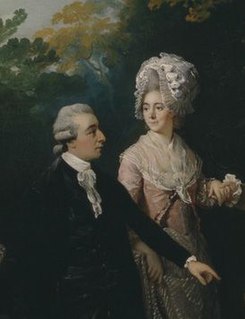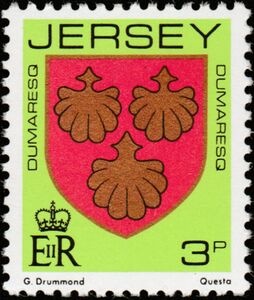Related Research Articles

Sir John Cowdery Kendrew, was an English biochemist, crystallographer, and science administrator. Kendrew shared the 1962 Nobel Prize in Chemistry with Max Perutz, for their work at the Cavendish Laboratory to investigate the structure of heme-containing proteins.

William Henry Dallinger FRS was a British minister in the Wesleyan Methodist Church. He was also an accomplished scientist, being the first to study the complete lifecycle of unicellular organisms under the microscope and studying the adaptation of such organisms to temperature.

Lieutenant-Colonel Henry Haversham Godwin-Austen FRS FZS FRGS MBOU, known until 1854 as Henry Haversham Austen, was an English topographer, geologist, naturalist and surveyor.

The Royal Medal, also known as The Queen's Medal and The King's Medal, is a silver-gilt medal, of which three are awarded each year by the Royal Society, two for "the most important contributions to the advancement of natural knowledge" and one for "distinguished contributions in the applied sciences", done within the Commonwealth of Nations.
Bryan Higgins was an Irish natural philosopher in chemistry.

Sir Charles Brian Blagden FRS was a British physician and scientist. He served as a medical officer in the Army (1776–1780) and later held the position of Secretary of the Royal Society (1784–1797). Blagden won the Copley Medal in 1788 and was knighted in 1792.

William Higgins, an Irish chemist, was one of the early proponents of atomic theory. Known mainly for his speculative ideas on chemical combination, William Higgins is popular for the insights his life offers into the emergence of chemistry as a career during the British Industrial Revolution. Despite an evident charm, his erratic behaviour and tendency to indulge personal animosities prevented him from engaging the affections of London society. Instead he found refuge in a succession of government-supported chemical positions in Dublin. Thanks to the combination of such scientific opportunities with family resources, he became a very wealthy man.

Charles Peter Layard, F.R.S., D.D. was Dean of Bristol from 1800 until his death.

The Fitzpatrick Lecture is given annually at the Royal College of Physicians on a subject related to history of medicine. The lecturer, who must be a fellow of the College, is selected by the president and may be chosen to speak for two years successively. The lectures are supported by funds from the Fitzpatrick Trust which was established in 1901 by Agnes Letitia Fitzpatrick with a £2,000 donation in memory of her physician husband Thomas Fitzpatrick. Agnes was influenced by her husband’s close friend, Sir Norman Moore, who persuaded her to choose ‘’history of medicine’’ as a subject. Subsequently, Moore was credited with its idea and implementation.
George William Clarkson Kaye was an English physicist. He is best known as one of the authors, together with Thomas Laby, of the authoritative scientific reference work Tables of Physical and Chemical Constants and Some Mathematical Functions, first published in 1911 and better known as Kaye and Laby. He was a driving force behind the formation and early years of the ‘International X-ray and Radium Protection Committee’ (IXRPC), the world's first international radiological protection body, created in 1928.
The Anti-Aircraft Experimental Section of the Munitions Inventions Department was an organisation set up within Lloyd George's Ministry of Munitions in early 1916. Originally based at Northholt aerodrome, in May 1916 the section moved to the National Physical Laboratory at Bushy House, Teddington before finding a more permanent home at HMS Excellent on Whale Island near Portsmouth in Hampshire. The section was led by the physiologist A. V. Hill, who was previously a Captain in the Cambridgeshire Regiment. While on leave suffering from flu in January 1916, Horace Darwin approached him to work on anti-aircraft measures. Hill accepted and started to find the personnel for the unit, which acquired the nickname "Hill's Brigands". Hill accepted and started to find the personnel for the unit, which acquired the nickname "Hill's Brigands".

The Dumaresq family was a patrician family in the Channel Islands with a particularly strong presence in Jersey. The family would hold many offices and positions throughout the history of Jersey from the 13th century.
References
- ↑ "Fellows of the Royal Society". London: Royal Society. Archived from the original on 16 March 2015.
- ↑ Hass, J. W. (2000). "The Reverend Dr William Henry Dallinger, F.R.S. (1839–1909)". Notes and Records of the Royal Society. 54 (1): 53–65. doi:10.1098/rsnr.2000.0096. ISSN 0035-9149. PMID 11624308. S2CID 145758182.
- ↑ "Lieut.-Col. H. H. Godwin-Austen, F.R.S". Nature. 112 (2826): 946. 1923. Bibcode:1923Natur.112..946.. doi: 10.1038/112946a0 . ISSN 0028-0836.
- ↑ "Jessel, Sir George (1824–1883), judge". Oxford Dictionary of National Biography (online ed.). Oxford University Press. doi:10.1093/ref:odnb/14803.(Subscription or UK public library membership required.)
- ↑ Bonney, Thomas George (1901). . Dictionary of National Biography (1st supplement). London: Smith, Elder & Co.
- ↑ Van der Kloot, W. (2013). "Lord Justice of Appeal John Fletcher Moulton and explosives production in World War I: 'the mathematical mind triumphant'". Notes and Records. 68 (2): 171–186. doi:10.1098/rsnr.2013.0056. ISSN 0035-9149. PMC 4006157 . PMID 24921109.
- ↑ O'Connor, John J.; Robertson, Edmund F., "Charles Niven", MacTutor History of Mathematics archive , University of St Andrews
- ↑ "Reynolds, (James) Emerson (1844–1920), chemist". Oxford Dictionary of National Biography (online ed.). Oxford University Press. doi:10.1093/ref:odnb/35729.(Subscription or UK public library membership required.)
- ↑ "Sir William Tilden, F.R.S. (1842–1926)". Nature. 150 (3798): 206. 1942. Bibcode:1942Natur.150R.206.. doi: 10.1038/150206b0 . ISSN 0028-0836.